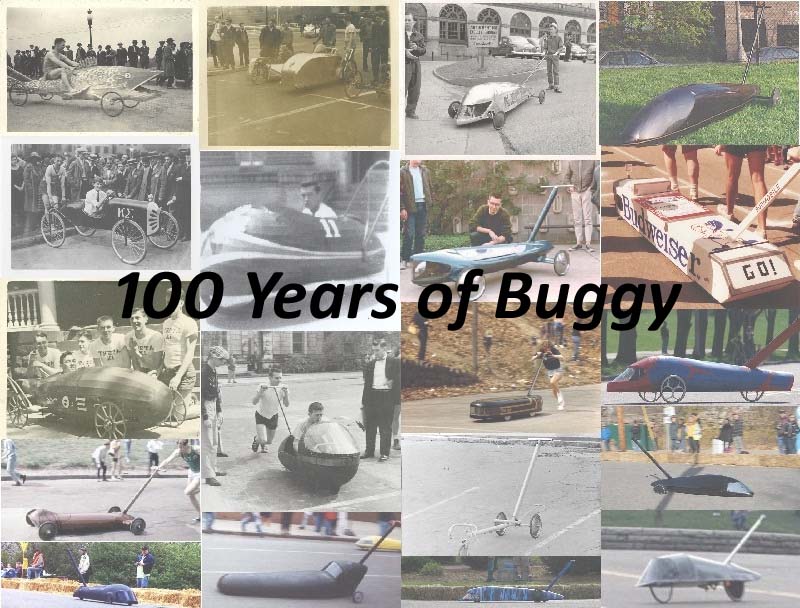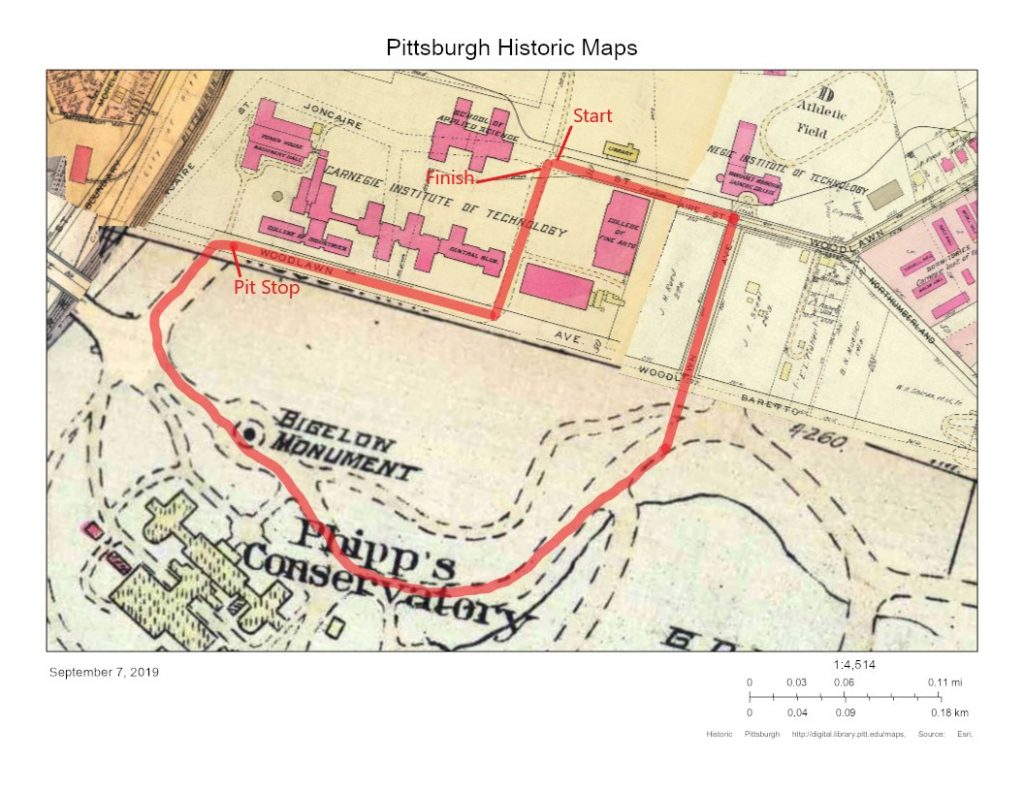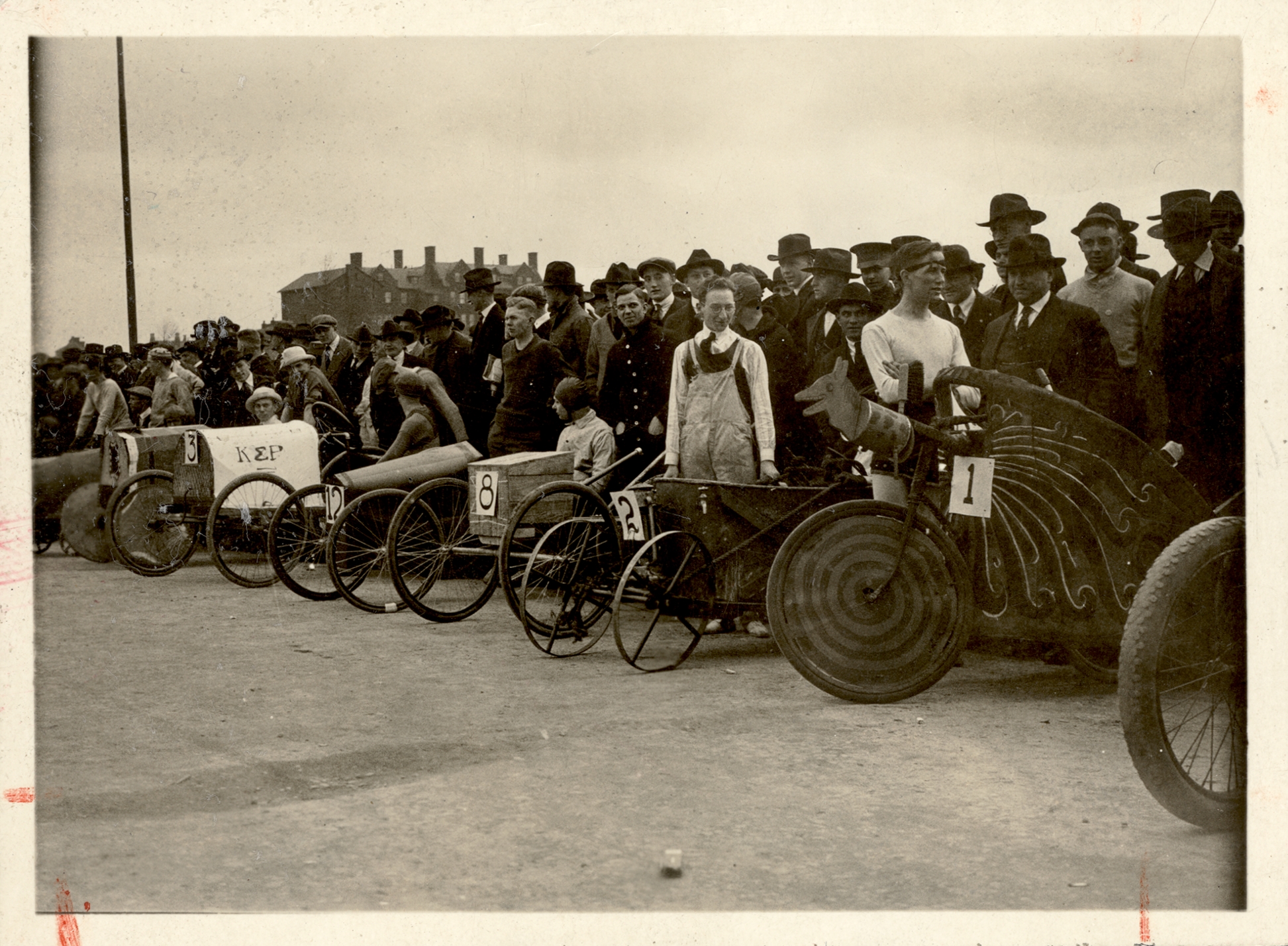Table of Contents: Intro & 1920; 1921-1923; 1924-1927; 1928-1932; 1933-1935; 1936-1939; 1940-1945; 1946-1949; 1950-1953; 1954-1956; 1957-1959; 1960-1963; 1964-1966; 1967-1969; 1970-1973; 1974-1976; 1977-1979; 1980-1983; 1984-1986; 1987-1989; 1990-1993; 1994-1996; 1997-1999; 2000-2003; 2004-2006; 2007-2009; 2010; 2011; 2012; 2013; 2014; 2015; 2016; 2017; 2018; 2019; Recap & 2020; 2021; 2022
Introduction
For those of you who haven’t been refreshing this site every 5 minutes since Raceday 2019 ended, this year is the 100th anniversary of Buggy at Carnegie Mellon! This year’s Raceday, which we are affectionately calling “Buggy 100” (#Buggy100), takes place on April 16-18, 2020, so make sure you’ve got the dates marked on your calendar.
As part of our big push to celebrate the Buggy Centennial this year, we are diving extra deep into our history. While the “History” tab of our site may give you the winners and their times, this year we wanted to take a more in depth look at the past 100 years of Buggy History at Carnegie Mellon. So with that said, we are introducing the “100 Years of Buggy History” series, which will run weekly (roughly) on the cmubuggy.org site. We’ll not only give you winners and times, but where possible, we’ll go into more detail about each year of Buggy. That includes information about Raceday – the weather, the crowds, the heats, the incidents, and the excitement – as well as any other interesting Buggy-related storylines that popped up over the course of the school year. We’ll also be loading up these posts with whatever photos, videos or other juicy gossip we can get our hands on from each of those years.
I doubt any of you were around for the early years (someone who participated in 1920 would be 117 years old today, and it turns out that as of today, the oldest living person is only 116). But if you have any interesting stories from the years of Buggy that you were around for, or if you know people (especially people like parents or grandparents, who may have participated in the early years) who have told you stories from their day, please let us know – you can email me at bryan.arsham@cmubuggy.org! We’d love to include that stuff.
The information that we put into this series is sourced from whatever records that we can get our hands on from the various years. Other than any stories we get from you all, the vast majority of this information comes from the excellent archives of the Carnegie Mellon University Libraries Digital Collections, with a significant percentage coming from The Tartan (other sources include the Thistle, the CIT Alumnus, and various Pittsburgh-area newspapers). But with that comes a couple of caveats, that I wanted to get out of the way now.
- The digital archives are not 100% complete, and coverage of Buggy was better in some years than others. For example, the digital archives are unfortunately missing 1937 (our current white whale), so we have very little information on that year, whereas the Tartan in 1976 essentially included weekly Rolls Reports, so we have a ton of information from that year.
- We weren’t around for a lot of these years, so if something was printed in our main sources incorrectly, or was misleading, we may not know. You might be surprised to find out that over the past 100 years, the reporting on buggy has not always been the most accurate! Take, for example, the 2019 Tartan article on Raceday, titled “SDC Wins Buggy For Second Year In A Row”, which isn’t technically wrong, but ignored that it was SDC’s third consecutive Women’s victory, and record eighth consecutive Men’s victory. Therefore, if we have any indication that a fact was incorrect (either it conflicts with something in our historical database, or it conflicts with another written report), we are either ignoring that piece of information or will call out the conflict in our post. Otherwise, for purposes of this series, we are accepting the written reports as true.
The number of years covered in each post will vary a bit based on how much information we have about the given year, but as of now, the plan is that most posts will cover roughly 5 years (give or take). We will also use today’s terminology (for example: CMU, rather than CIT, to refer to the school) as appropriate to make the history as understandable as possible for today’s readers.
So without further ado, let’s kick off the 100 Years of Buggy History series with the origins of Buggy: 1920.
1920
Raceday: May 14, 1920
Sweepstakes Chair: R.M. Crosby
Race Winner: Tau Gamma Phi (which became DTD)
Design Comp Winner: Sigma Nu
Weather: Sun was shining; temperature unknown
1920 used to be our White Whale. We knew that Buggy began in 1920, but the results, and information about the races, were lost to history. That is, until our own BAA Vice President Jeremy Tuttle went digging a little more, and discovered the June 1920 CIT Alumnus. The CIT Alumnus was a (mostly) bimonthly alumni newsletter published until roughly 1982, and although it did not regularly cover Buggy, there were some important historical references in those early years. So, what do we know about 1920 – the first year of Buggy?
- “The greatest, wildest, jazziest, most blood-curdling, hair-raising, breath-stopping, shirt-tearing event in Tech annals” got its start at Carnegie Mellon on April 21, 1920, with an announcement in The Tartan about the Interfraternity Motor Sweepstakes taking place during Campus Week.
- The very first Raceday had only 5 rules (compared to today’s 100+ page rulebook):
- All buggies must be equipped with 4 wheels
- The crew of each team will consist of 2 men – a driver and a pusher – who may change places at any time
- The minimum weight of the buggy is 75 pounds
- The rear wheels of each buggy must be interchangeable, and during the race each buggy will be required to pit and swap the left rear and right rear wheels
- Only 1 man on each team may have his feet on the ground at 1 time, except in the pit.
- 10 fraternities entered the inaugural race. We don’t know which 10 (there were 14 National and Local Fraternities on campus in 1920), but 5 are confirmed: Sigma Nu, Sigma Rho (which became Beta Theta Pi in the afternoon following Raceday 1920), Theta Xi, Tau Gamma Phi (which would become DTD in 1923), and Kappa Sigma Rho (which became Lambda Chi Alpha in 1929, and went dormant in 1935). Others believed to be present in 1920, based on participation in later years (but no confirmations of 1920 participation), include Sigma Alpha Epsilon and Delta Upsilon.
- The course was a little different than today. It began outside the Design school (CFA), travelled towards Margaret Morrison Hall, went up Tech Street, down through Schenley Park (Schenley Drive), and then turned back on to campus at Machinery Hall (the Chute). Outside Machinery Hall, the buggies would pit and the rear wheels would be swapped. The buggy would then continue past the College of Industries, and end back where it started outside the Design school. A rough estimate of the course is shown on the right.
- We don’t have a ton of information about the race itself. What we do know is that the race was won by Tau Gamma Phi, and that they were awarded a trophy. In second place was Sigma Nu, while both Beta Theta Pi and Theta Xi saw their buggies break down during the race.
- Although SigNu didn’t win the race, they did win the very first Design Competition. The SigNu buggy was a “chariot built around a bicycle”, while the 2-man team dressed as charioteers. From the description, I suspect that SigNu is Buggy #1 in the photo to the right.
- Not all of the buggies were designed with speed in mind. One fraternity “used their ingenuity” to use a bathtub on wheels (which I suspect is Buggy #2 in the photo to the right). Reports are that the buggy gave a very realistic rolling motion when in action.
- Wheel technology has always been on the forefront of the buggy builder’s mind, and that was no different in 1920 – the Carnegie Alumnus reports that wheel technology included wire wheels, wooden wheels, bicycle wheels, and even roller skates.
- Lastly, I have to commend the writers of the various Tartan articles from 1920. The language used back then was very colorful and made for an enjoyable reading experience. I’ll give some examples of that language coming up next week, as we move forward in the 1920s.

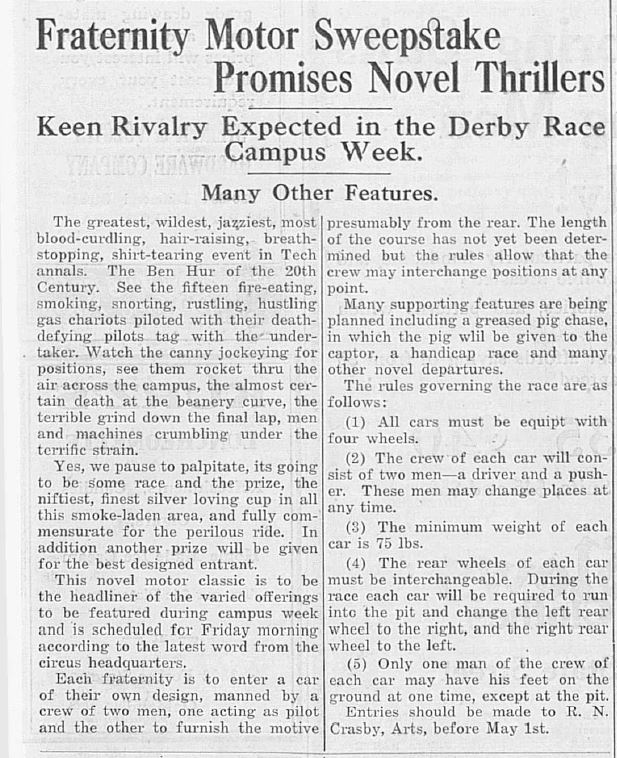
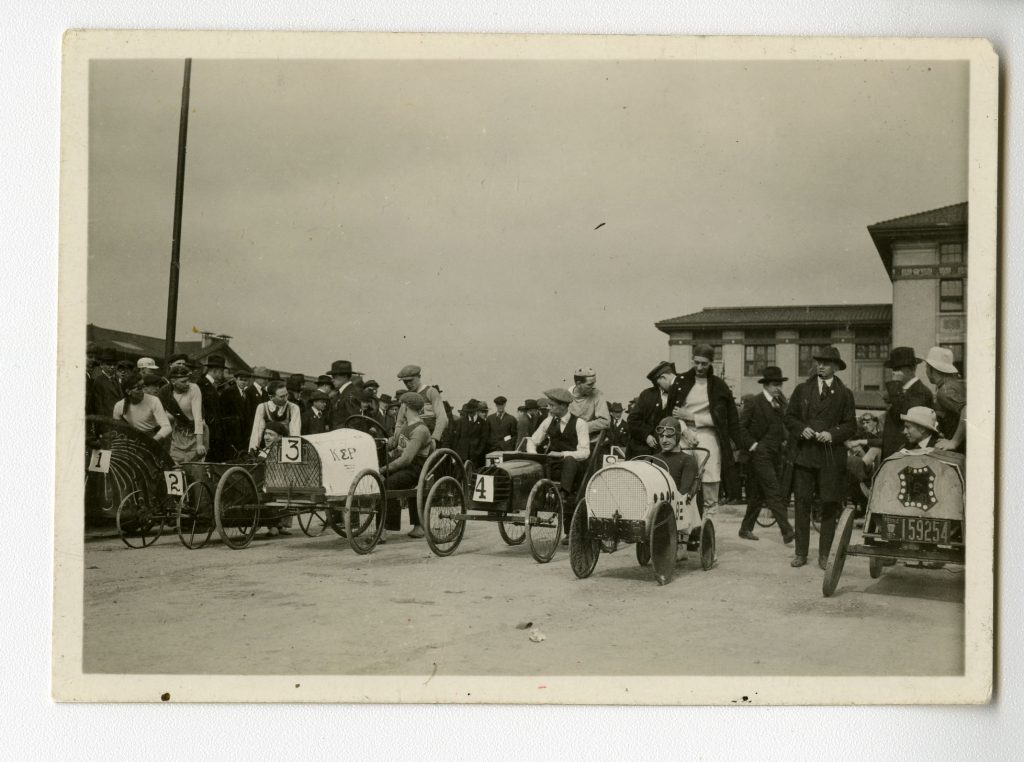
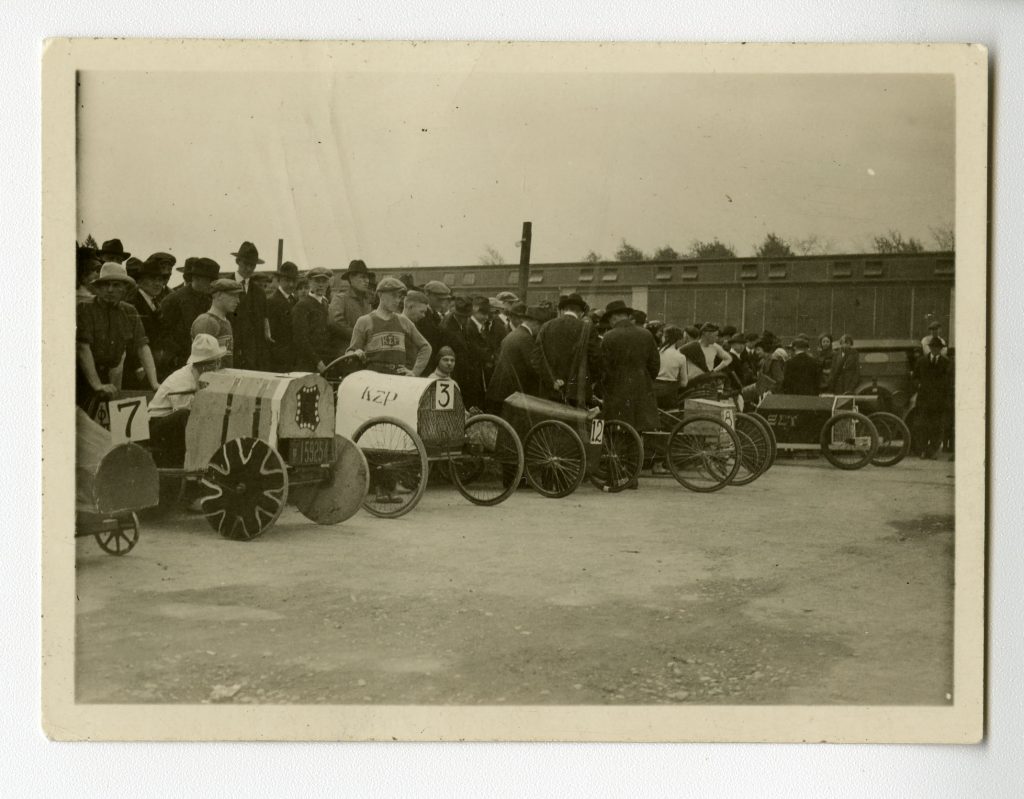
Read More 100 Years of Buggy Articles
- 1921-1923
- 1924-1927
- 1928-1932
- 1933-1935
- 1936-1939
- 1940-1945
- 1946-1949
- 1950-1953
- 1954-1956
- 1957-1959
- 1960-1963
- 1964-1966
- 1967-1969
- 1970-1973
- 1974-1976
- 1977-1979
- 1980-1983
- 1984-1986
- 1987-1989
- 1990-1993
- 1994-1996
- 1997-1999
- 2000-2003
- 2004-2006
- 2007-2009
- 2010
- 2011
- 2012
- 2013
- 2014
- 2015
- 2016
- 2017
- 2018
- 2019
- Recap & 2020
- 2021

